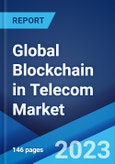The global blockchain in telecom market size reached US$ 447.4 Million in 2022. Looking forward, the market is expected to reach US$ 7,591.4 Million by 2028, exhibiting a growth rate (CAGR) of 60.30% during 2022-2028.
Blockchain refers to a decentralized technological solution used for recording, collecting and maintaining a transaction history of a digital asset between two or more parties. It is linked through cryptography for providing a time-stamp of the transaction. It is widely used by organizations to prevent thefts, streamline administrative procedures, create transparent networks, store unique device data and curb fraudulent activities. Blockchain in telecom is widely used for smart contracts, connectivity provisioning, identity management, payment and billing. It also aids in providing instant traceability and automation and increasing the operational efficiency of the business process. It maintains the historical records of users that can be verified by other stakeholders and cannot be tampered with.
Blockchain refers to a decentralized technological solution used for recording, collecting and maintaining a transaction history of a digital asset between two or more parties. It is linked through cryptography for providing a time-stamp of the transaction. It is widely used by organizations to prevent thefts, streamline administrative procedures, create transparent networks, store unique device data and curb fraudulent activities. Blockchain in telecom is widely used for smart contracts, connectivity provisioning, identity management, payment and billing. It also aids in providing instant traceability and automation and increasing the operational efficiency of the business process. It maintains the historical records of users that can be verified by other stakeholders and cannot be tampered with.
Blockchain in Telecom Market Trends
The rising security concerns among telecom organizations across the globe is one of the key factors driving the growth of the market. Blockchain in telecom provides enhanced security as it uses cryptography encryption to protect all transactions. Additionally, the increasing demand for smart contracts is providing a thrust to the market growth. Blockchain is widely used to automate the execution of an agreement with predetermined conditions. Moreover, various technological advancements, such as the integration of the Internet of Things (IoT) and artificial intelligence (AI) with connected devices, are favoring the market growth. These technologies enable smart devices to send data and create tamper-resistant records of the shared transactions. Other factors, including the integration of blockchain solutions for the implementation of 5G technology, along with the increasing utilization of blockchain-based mobile wallet payments, are anticipated to drive the market toward growth.Key Market Segmentation
This research provides an analysis of the key trends in each sub-segment of the global blockchain in telecom market report, along with forecasts at the global, regional and country level from 2023-2028. The report has categorized the market based on provider, organization size and application.Breakup by Provider:
- Application Providers
- Middleware Providers
- Infrastructure Providers
Breakup by Organization Size:
- Small and Medium-sized Enterprises
- Large Enterprises
Breakup by Application:
- OSS/BSS Processes
- Identity Management
- Payments
- Smart Contracts
- Connectivity Provisioning
Breakup by Region:
- North America
- United States
- Canada
- Asia-Pacific
- China
- Japan
- India
- South Korea
- Australia
- Indonesia
- Europe
- Germany
- France
- United Kingdom
- Italy
- Spain
- Russia
- Latin America
- Brazil
- Mexico
- Middle East and Africa
Competitive Landscape
The competitive landscape of the industry has also been examined along with the profiles of the key players being Amazon.com Inc., Blockchain Foundry Inc., Cegeka, Deloitte Touche Tohmatsu Limited, Huawei Technologies Co.Ltd., Infosys Limited, International Business Machines Corporation, Microsoft Corporation, Oracle Corporation, SAP SE, Tbcasoft Inc. and Wipro Limited.Key Questions Answered in This Report:
- How has the global blockchain in telecom market performed so far and how will it perform in the coming years?
- What has been the impact of COVID-19 on the global blockchain in telecom market?
- What are the key regional markets?
- What is the breakup of the market based on the provider?
- What is the breakup of the market based on the organization size?
- What is the breakup of the market based on the application?
- What are the various stages in the value chain of the industry?
- What are the key driving factors and challenges in the industry?
- What is the structure of the global blockchain in telecom market and who are the key players?
- What is the degree of competition in the industry?
Table of Contents
1 Preface3 Executive Summary11 Value Chain Analysis13 Price Analysis
2 Scope and Methodology
4 Introduction
5 Global Blockchain in Telecom Market
6 Market Breakup by Provider
7 Market Breakup by Organization Size
8 Market Breakup by Application
9 Market Breakup by Region
10 SWOT Analysis
12 Porters Five Forces Analysis
14 Competitive Landscape
Companies Mentioned
- Amazon.com Inc.
- Blockchain Foundry Inc.
- Cegeka
- Deloitte Touche Tohmatsu Limited
- Huawei Technologies Co.Ltd.
- Infosys Limited
- International Business Machines Corporation
- Microsoft Corporation
- Oracle Corporation
- SAP SE
- Tbcasoft Inc.
- Wipro Limited
Methodology

LOADING...
Table Information
| Report Attribute | Details |
|---|---|
| No. of Pages | 146 |
| Published | November 2023 |
| Forecast Period | 2022 - 2028 |
| Estimated Market Value ( USD | $ 447.4 Million |
| Forecasted Market Value ( USD | $ 7591.4 Million |
| Compound Annual Growth Rate | 60.3% |
| Regions Covered | Global |
| No. of Companies Mentioned | 12 |








